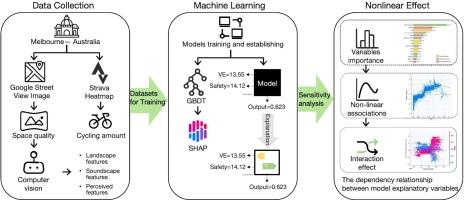解码视听街道环境特征对骑行量的影响:来自街景图像和机器学习的见解
IF 6.8
1区 工程技术
Q1 ECONOMICS
Transportation Research Part A-Policy and Practice
Pub Date : 2025-07-05
DOI:10.1016/j.tra.2025.104586
引用次数: 0
摘要
了解街道视听环境与骑行行为之间的关系对于设计更具包容性和响应性的交通环境至关重要。然而,大多数先前的研究都集中在建筑环境的宏观层面,如土地利用组合,而忽视了影响骑自行车者现场感知的街道空间质量特征。虽然研究已经探讨了客观视觉特征的作用,但对街道视听环境及其感知影响的研究仍然很少。本研究结合街景图像、Strava热图数据和可解释的机器学习来研究街道空间质量对自行车量的非线性和交互影响。结果表明:(1)听觉特征(尤其是噪声强度和声音质量)对骑行量的影响显著且往往比视觉特征更强,挑战了以视觉为中心的规划假设;(2)一些空间特征呈现非线性或阈值效应(如绿色景观指数和声景观事件性呈现倒u型曲线),表明过度的环境丰富度可能会降低骑行吸引力;(3)视觉和听觉元素之间存在协同和拮抗相互作用,如自然声音可以减轻高噪声的负面影响,而封闭的视觉环境则会放大高噪声的负面影响。这些发现提供了经验证据,证明优化——而不是最大化——街道层面的感官刺激对于促进主动出行至关重要。基于这一见解,我们的研究为政策制定者和城市设计师提供了实用指导,以实施更有针对性和环境敏感的干预措施,并强调了将视听设计融入可持续交通规划的潜力。本文章由计算机程序翻译,如有差异,请以英文原文为准。

Decoding the impact of audiovisual street environment features on cycling volumes: Insights from street view imagery and machine learning
Understanding the relationship between the audiovisual environment of streets and cycling behavior is crucial for designing more inclusive and responsive transport environments. However, most previous studies have concentrated on the macro-level aspects of the built environment, such as land-use mix, while overlooking the street-space quality characteristics that influence cyclists’ on-site perceptions. Although research has explored the role of objective visual features, studies on the audiovisual environment of streets and its perceived impact remain scarce. This study combines street view imagery, Strava Heatmap data, and interpretable machine learning to investigate the nonlinear and interactive effects of street-level spatial quality on cycling volumes. The results indicate that (1) auditory characteristics—especially noise intensity and sound quality—exert a significant and often stronger influence on cycling volume than visual features alone, challenging visual-centric planning assumptions; (2) several spatial features show nonlinear or threshold effects (e.g., green view index and soundscape eventfulness exhibit inverted U-shaped curves), indicating that excessive environmental richness may reduce cycling appeal (3) synergistic and antagonistic interactions exist between visual and auditory elements—for instance, natural sounds can mitigate the negative impact of high noise, while enclosed visual environments amplify it. These findings provide empirical evidence that optimizing—rather than maximizing—street-level sensory stimuli is essential for promoting active travel. Building on this insight, our study offers practical guidance for policymakers and urban designers to implement more targeted and context-sensitive interventions, and underscores the potential of integrating audiovisual design into sustainable transport planning.
求助全文
通过发布文献求助,成功后即可免费获取论文全文。
去求助
来源期刊
CiteScore
13.20
自引率
7.80%
发文量
257
审稿时长
9.8 months
期刊介绍:
Transportation Research: Part A contains papers of general interest in all passenger and freight transportation modes: policy analysis, formulation and evaluation; planning; interaction with the political, socioeconomic and physical environment; design, management and evaluation of transportation systems. Topics are approached from any discipline or perspective: economics, engineering, sociology, psychology, etc. Case studies, survey and expository papers are included, as are articles which contribute to unification of the field, or to an understanding of the comparative aspects of different systems. Papers which assess the scope for technological innovation within a social or political framework are also published. The journal is international, and places equal emphasis on the problems of industrialized and non-industrialized regions.
Part A''s aims and scope are complementary to Transportation Research Part B: Methodological, Part C: Emerging Technologies and Part D: Transport and Environment. Part E: Logistics and Transportation Review. Part F: Traffic Psychology and Behaviour. The complete set forms the most cohesive and comprehensive reference of current research in transportation science.

 求助内容:
求助内容: 应助结果提醒方式:
应助结果提醒方式:


